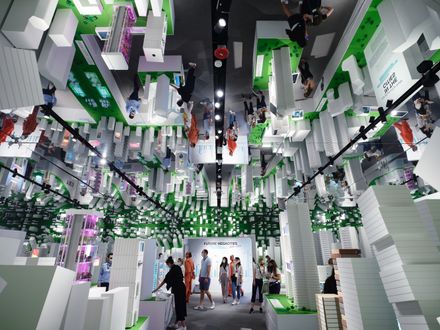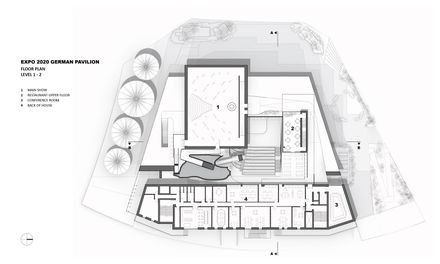German Pavilion Expo 2020 Dubai
REUSE
Certain Measures
CLIMATE DESIGN
Transsolar
FIRE PROTECTION
Steinlehner
LEAD ARCHITECTS
Tobias Wallisser, Alexander Rieck, Chris Bosse With Christian Tschersich
PROJECT TEAM
Maria Pachi, Ahmed Rihan, Niklas Knap, Daniele Colombati, Wassef Dabboussi
LIGHTING DESIGNERS
Kardorff Ingenieure
CLIENT CONSORTIUM
Facts And Fiction With Nussli Adunic
MINISTRY
Federal Ministry For Economic Affairs And Energy (Bmwi)
CONCEPT DESIGN, PLANNING AND IMPLEMENTATION
Facts And Fiction/nussli
COMPETITION TEAM
Maria Pachi, Christina Ciardullo, Courtney Jones, Jed Finanne, Benjamin Riess, Joanna Rzewuska
PHOTOGRAPHS
Taufik Kenan, Roland Halbe, Facts And Fiction Nussli Adunic Photographer Andreas Keller
STRUCTURAL ENGINEERS
Schlaich Bergermann Partner
MEP
Energytec
AREA
4600 m²
YEAR
2021
LOCATION
Dubai, United Arab Emirates
CATEGORY
Pavilion
Text description provided by architect.
LAVA’s design of the German Pavilion at Expo 2020 Dubai is an ensemble of suspended cubes, a forest of steel poles, covered by a floating roof. And behind these visually exciting design elements, everything from the intelligent use of local climatic conditions to materials reuses to connectedness is sustainable.
1. BUILDING AS EXHIBIT: SOCIAL SUSTAINABILITY
positioning of the cantilevered cubes generates a spacious central atrium for gatherings and events. At the heart of the visitor experience, this covered vertical space visually connects all functional areas with one another, helps with way-finding, creates diverse visual relationships and access points, and assists with the management of large visitor numbers.
The visitor route brings people continuously onto terraces (on top of the cubed spaces). They see their past and future trajectory, engage with other people and enjoy vistas out to the Expo site.
The exhibition spaces, designed by facts and fiction, (Energy Lab, Future City Lab, and Biodiversity Lab) feature individual immersive experiences inside the cubes, whilst terrace exhibitions invite group interaction.
Rather than a traditional exhibition hall, the campus metaphor sees the whole building as an exhibit, not merely a canvas to display, but a tool for connecting people and content, and a place to experience German innovations.
BUILDING AS EXHIBIT: STRUCTURAL SUSTAINABILITY
Three cubes were stacked on top of a plinth with other functions (restaurant, pre-show, office, back-of-house) formed as an abstract landscape.
This created a large volume at the centre, and a roof creates shade and comfort – a technical cloud. A sandwich of three parts: landscape – stacked cubes – roof. People between nature and technology.
2. BUILDING AS EXHIBIT: STRUCTURAL SUSTAINABILITY
Three cubes were stacked on top of a plinth with other functions (restaurant, pre-show, office, back-of-house) formed as an abstract landscape.
This created a large volume at the centre, and a roof creates shade and comfort – a technical cloud. A sandwich of three parts: landscape – stacked cubes – roof. People between nature and technology.
The clever positioning of the stacked cubes is driven by local climate and features passive energy-saving features that reduce the impact of direct sunlight, generate natural shade, decrease the heat load and optimise the indoor climate.
This intelligent creation of shade by the building elements also makes “hybrid” air conditioning possible. It also references the design of the local courtyard house, with closed exterior facades and rooms oriented towards an inner airspace that open up to each other.
A hybrid facade minimises the sense of building bulk and creates an iconic framing of the space. At the upper level a dynamic arrangement of 900 vertical steel poles, a forest of trees
An opaque, trapezoidal single-layer ETFE membrane can be opened and closed, responsive to different weather conditions during the six-month Expo period, such as sandstorms and cooler days, and minimises the need for air conditioning.
The pavilion’s outer shell also includes 1.5 metres-wide glass elements that can be rotated and opened, allowing the building to
LAVA’s bottom-up approach focussed on visitor comfort, technology in the service of humans. “At LAVA we’re always looking at the interaction between people and the physical environment they inhabit. Sustainability requires that environments are adaptable and changeable,” added Wallisser.
The transition from hot exterior to inside was carefully considered. To reduce temperature shock and save on energy costs the architects designed a transitional space where visitors entering the building, with lengthy queues, are cooled by a gentle water mist emanating from steel poles allowing them to gradually acclimatise.
The central atrium is cooled by cold air expelled from the air-conditioned exhibition spaces, thereby reducing energy usage and improving visitor comfort.
The visually striking technical cloud roof creates shade and comfort. It allows daylight into the interior through multiple small openings, similar to sunlight penetrating a forest canopy, creating an ever-changing visitor experience.
Mirror surfaces reflect direct sunlight against the roof skin, a dynamic interplay of light. At night, a field of LED lights integrated in the ceiling make the building radiate from within.
Resource consumption and the circular economy were also major design drivers and are reflected in numerous passive and active sustainability features - from Design for Disassembly (DfD) to “Mine the Scrap”, “grey energy”, sustainable and reusable building materials. 95% of the building will be repurposed after the Expo is finished, with standardised building elements such as steel poles dismantled and reconfigured into different geometries.


































